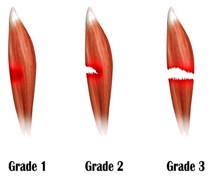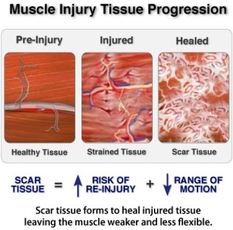|
What is a Muscle Strain? Often called a muscle pull, a strain is any damage to a muscle or a tendon. Before I talk about what to do if you experience a muscle strain, it is important to understand the different types, or levels, of these injuries. Grade I: A grade I strain, often called a mild muscle strain, occurs when the fibers of the muscle or tendon are overstretched. There may or may not be a few small tears in this type of strain. You will likely experience mild pain with some mild swelling in this type of injury. This is the most common type of muscle strain seen. Grade II: Also referred to as a moderate muscle strain, these are slightly more serious than grade I in that the muscle is even more overstretched and some of the fibers are torn, though there is not a complete tear of the muscle or tendon. Likely symptoms include more pain and swelling, along with bruising and some difficulty moving that part of the body. Grade III: A severe muscle strain is one in which most of the fibers are completely torn, or in some cases the muscle is completely torn or ruptured. Movement is usually very difficult and you will see even more pain, swelling, and bruising than Grade II strains. More severe muscle strains, including Grade III’s and even some bad Grade II’s should be seen by a medical professional to determine the best treatment options. Grade I injuries are much more common and respond better to more conservative treatment options. So I Have a Muscle Strain, What Do I Do? The most important first step following a mild muscle strain is to rest. If the muscle is damaged, doing activities or exercises that use that muscle will only damage it even more. Using ice and compression can also aid in managing the pain and swelling that may be present. If there is swelling around the area, elevating the limb will help to decrease some of that swelling. Build back up slowly. Once you are ready to return to your sport or activity, don’t just jump right back in where you left off. This increases the chance of a re-injury. Start off slow and gradually work your way back up to the level you were at prior to injury. If you start to feel any pain, take a step back. Grade I injuries tend to heal rather quickly if these steps are taken, often times in as little as 1-2 weeks. If you are experiencing pain that lasts longer than this, it is a good idea to see a medical professional for a proper evaluation and diagnosis. How Can Physical Therapy Help?
A physical therapist can do the following:
1 Comment
7/19/2019 04:10:23 am
Muscle strains can be a huge problem to deal with. If you do not take care of your muscles, then you will have a higher chance of encountering muscle strains. To be honest, you will have to invest your time to exercise if you want to properly deal with it. I hope that you have learned something from this blog, because I did. I have learned so much when it comes to dealing with and preventing muscle strains and stress.
Reply
Leave a Reply. |
Archives
April 2022
Categories
All
Disclaimer: The information contained on this website is compiled from a variety of professional sources as well as the author's own experiences. The information should NOT be used in place of a visit to your healthcare provider or used to disregard any advice provided by your healthcare provider.
|



 RSS Feed
RSS Feed